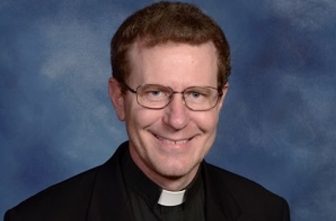
Have you ever had an experience so profound and so out-of-the-norm that you were tongue-tied in trying to convey to others the impact of that experience?
Imagine what it must be like for a newborn child to try to communicate the difference between the life he or she knew in the womb and the post-birth life the child now experiences. Then all sounds from outside the mother’s body were muffled, with the sound of the mother’s constant heartbeat in the auditory forefront; now the newborn is bombarded by human speech, mechanical noises and (possibly) lullabies, with the constant sound of the mother’s heartbeat absent.
Then it was questionable if the child in the womb could see any objects at all; now the newborn is assaulted by a panoply of bright lights and colors. Even if he or she had command of a language, how difficult it would be for the newborn to communicate the radically new form of life he or she now experiences?
Something analogous happened for our ancestors in the faith as they witnessed to and grappled with the resurrection of Jesus. Nothing like what had happened in and to Jesus had ever occurred in human history.
Jewish thinking on the topic by the time of Jesus did not so much envision resurrection as an event for each individual, but as a corporate event, when God would raise all of the elect at the end of history. In this belief system God raises Jesus from the dead as the “first fruits” of the general resurrection (1 Cor 15:20). It is in the context of this hope that early Christian preachers developed three powerful ways of communicating the resurrection of Jesus: “kerygmatic formulae,” empty-tomb narratives and appearance stories.
“Kerygmatic formulae” are short creedal statements of belief, the earliest of which probably appear in 1 Cor 15:3-8. Today’s first reading, Peter’s speech in Acts 10, consists almost entirely of “kerygmatic formulae,” the most important of which for Easter Sunday is the contrast: “They (those ‘in the country of the Jews and in Jerusalem’) put him (Jesus) to death by hanging him on a tree. This man God raised on the third day … .”
We believe that empty-tomb narratives belong to a later stage of trying to communicate the resurrection of Jesus, especially since they will often include a kerygmatic formula uttered by one of the people in the story. These narratives probably stem from a primitive report that Mary of Magdala and other women came to the tomb where Jesus was laid, only to discover that the tomb was empty. By itself, the discovery of an empty tomb does not establish the reality of the resurrection of Jesus. Jesus’ body could have been resuscitated and left the tomb, or the women may have been mistaken about the tomb in which they believed Jesus had been laid, or forces hostile to the Jesus movement or Jesus’ own disciples may have stolen the body and spirited it away to another location, etc. (cf. Mk 15:47; Mt 28:13; Lk 20:15).
Today’s Gospel reading (Jn 20:1-9) is clearly an empty-tomb narrative in which Mary of Magdala, the Beloved Disciple and Simon Peter all discover that Jesus is not among the dead, but only the Beloved Disciple “saw and believed” based on the immediate evidence.
The third form in which ancient Christian preachers and the Christian Scriptures attempt to communicate the resurrection of Jesus is through appearance narratives. In these stories, the risen Christ reveals himself to those who can receive him: Jesus walks, talks, eats, drinks and offers himself to be touched.
Peter’s speech in Acts 10 presents a report of an appearance narrative: “This man (Jesus) God raised on the third day and granted that he be visible, not to all the people, but to us, the witnesses chosen by God in advance, who ate and drank with him after he rose from the dead.”
However, the most vivid appearance narrative in today’s lectionary readings occurs in the sequence “Victimae paschali laudes,” where the details of the empty tomb story (“the shroud and napkin resting”) found in the Gospel meld with those of an appearance narrative with Mary of Magdala in the garden.
This leaves only the alternative selections for today’s second reading to be considered (1 Cor 5:6b-8. They are both examples of “paraenesis,” an exhortatory composition offering advice and counsel on how to act. Especially interesting is the use of yeast as a metaphor in 1 Corinthians. In the ancient world, observers considered the action of yeast to be corrupting, making a batch of dough leavened just as corrupting as a dead body bloated from gases released as it decomposes. The Apostle counsels us to get rid of the “yeast of malice and wickedness” so that we might be “unleavened bread of sincerity and truth.” In other words, the Resurrection must have its effects not only on Jesus, but on those of us who form the body of the Risen One.
Father Joncas, a composer, is an artist in residence at the University of St. Thomas in St. Paul.
Sunday, April 21
Easter Sunday




